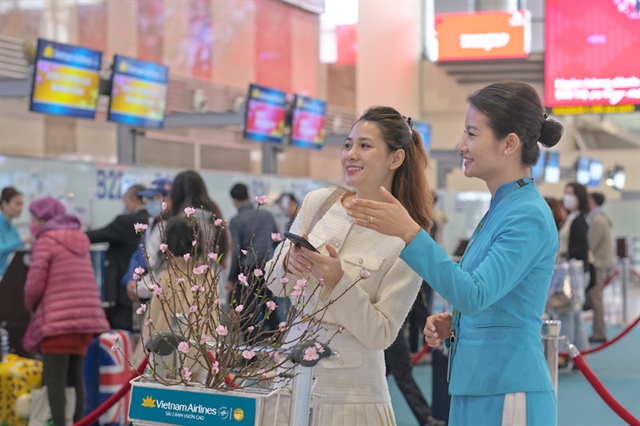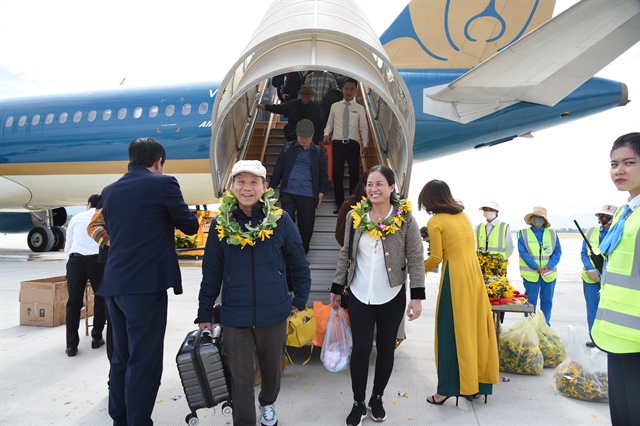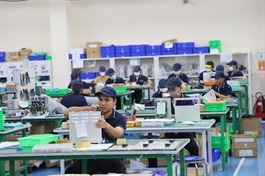Vietnam’s aviation industry eyes full recovery by 2024
Vietnam’s aviation industry eyes full recovery by 2024
This year, Vietnamese airlines are expected to carry around 61 million passengers, an increase of 9.3% over last year.
Vietnam’s aviation industry is forecast to fully recover by the end of 2024, based on trends in the Asia-Pacific region, according to the latest projection from the Civil Aviation Authority of Vietnam (CAAV).
Total air traffic is expected to hit about 84.2 million passengers in 2024, up 15% from 2023 and 6% from 2019, the authority said.

From January 11 through February 24, each passenger may check in with an apricot or peach blossom branch. Photos: Vietnam Airlines |
Domestic air traffic is estimated to hit around 41.5 million, an increase of 3.3% from 2023 and 11% from 2019. International passenger traffic would reach approximately 42.7 million, up 15.8% from 2023 and 6.4% from 2019. International passenger transport is expected to total 19.5 million passengers, an uptick of 24.6% from 2023 and 10.6% compared to 2019.
Regarding freight, total demand is expected to rise to 1.16 million tonnes in 2024, an upsurge of 8.5% from 2023 and 92.2% from 2019.
CAAV said the market is expected to benefit from favorable factors such as the tourism development policies of domestic and international destinations.
"In addition, the planning and opening of new routes by Vietnamese and foreign airlines are also opportunities for market development," CAAV's management said.
In addition to the advantages and opportunities, the Authority recognizes that the aviation industry still faces many challenges and risks that could directly affect its recovery and development.
The challenges and risks include unresolved uncertainties and negative factors affecting economic growth, both domestically and internationally, such as the risk of inflation, continued exchange rate appreciation, tight monetary policies in many countries, interest rates not in line with the current situation, and unfavorable developments in aviation fuel prices, the Vietnamese authority pointed out.
Multiple leverage policies in place

The first passengers from Hanoi landed at Dien Bien Airport. |
The Vietnam Civil Aviation Administration has reaffirmed its commitment to closely monitor the situation, forecast market demand, and coordinate with airlines and industry units to find timely and appropriate solutions to the current circumstances.
It has also proposed that the government reduce certain taxes and fees until the end of 2024 and implement interest support policies for enterprises in the aviation industry. They also encourage Vietnamese airlines to ensure transportation capacity and increase operational capacity.
It will cooperate with foreign aviation authorities to support Vietnamese airlines operating at their airports. In addition, it will continue to help airlines strengthen their transportation capacity by adding aircraft to their fleets to help accelerate recovery and development.
In addition, CAAV encourages Vietnamese airlines to operate international routes from airports other than Noi Bai in Hanoi and Tan Son Nhat in Ho Chi Minh City, such as Danang City, Cam Ranh, Hue, Phu Quoc Island, Van Don, Cat Bi, and other domestic airports capable of operating international flights, such as Lien Khuong (Dalat City in the southern province of Lam Dong) and Phu Cat (in the central province of Binh Dinh).
CAAV encourages Vietnamese airlines to strengthen cooperation with tour operators and local communities to implement tourism promotion programs, offer air travel packages, and expand charter flights from emerging markets in South Korea, China and Japan to tourist destinations in Vietnam.

























